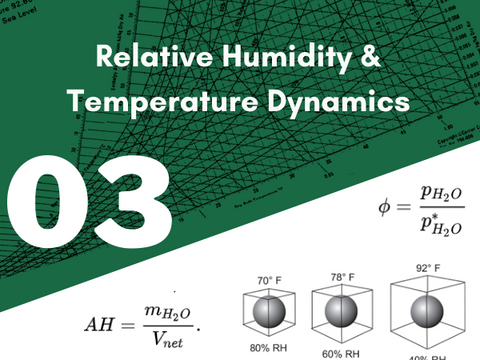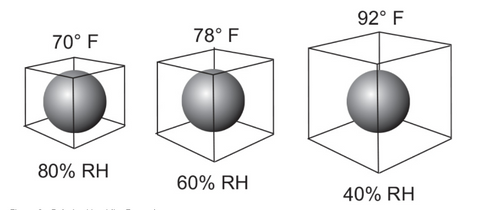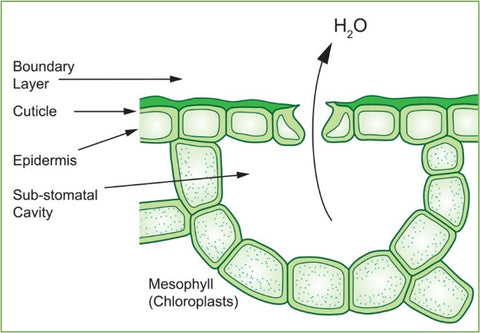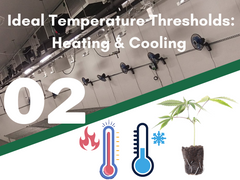
Humidity is the driving factor behind optimal plant growth and can be the major issue for green house and indoor cannabis growers as well as an issue prior to harvest on the mature flowering plant outdoors. Depending on the strain of cannabis plant and your cultivation system you will have to determine the parameters for the plant to simulate or mitigate that slow change in humidity levels over the course of their growth cycles to maximize your yield.
Maintain the Right Humidity
Relative humidity is the a percentage or ratio of the amount of water vapor in a volume of air relative to a given temperature and the amount it can hold at that given temperature.[1] As the air temperature increases, the total volume of the air molecules increases. Conversely when air temperature decreases, the volume of the air molecules decreases. Water, however, is not compressible. Therefore given a specific amount, it will always occupy the same amount of volume. Figure 1 above illustrates graphically how this works. As moisture-laden air is heated or cooled the air volume changes but the amount of moisture in the air does not.[2]
Young plants are relatively robust, and can take higher humidity levels, even as high as 80%. During this vegetative stage, low humidity can actually be harmful. If levels drop lower than 40% it will cause the plants to look like they’re burned from heat or light stress.

Inversely, plants during the flowering stage prefer much drier environments, preferably below 45%. The parameters of your grow room during the fruiting stage should drift between 45% and 50% relative humidity.
Why is Humidity Crucial?
Humidity levels change the amount of water the plants will drink. Plants in humid environments will drink in less water through their roots, while plants in drier air will suck up more each time they are watered.
Plant Requirements
Plants utilize photosynthesis to feed themselves using a light dependent and light independent reaction. Photosynthesis consists of two stages, the light-dependent reactions or photo stage: and the Calvin cycle or light-independent stage. Plants that are exposed to light convert water and carbon dioxide into food. Through another process called transpiration, plants use water to carry nutrients throughout their tissues then release this water as water vapor. Plants release water vapor via tiny openings in plant surfaces called stomata to the surrounding, boundary layer air.
The temperature of leaves and their internal vapor pressures drive this exchange of gases; and the vapor pressures exerted on leaves by boundary layer air. The process of changing internal liquid water into a gaseous state consumes energy. For grow rooms and indoor farms the sources of this energy are facility lighting systems.
Vapor Pressure Deficient
As a rule of thumb gases and liquids move from an area of high concentration to low. Vapor pressure deficit is a metric that indicates the evapotranspiration potential of grow rooms based on current temperatures and humidity levels. This is a crucial measurement to understand in greenhouse and indoor grow settings. The value is the deficit or differential between the pressure exerted by the moisture at a specific room condition, and the pressure at saturation. The assumption is made that the surface conditions of plant leaves are equal to that of the saturated conditions surrounding them

When a space is at 100% relative humidity no more water can be absorbed by the air, consequently no further evapotranspiration can occur from plants. When the temperature increases, plants will need to transpire more. Cultivators must control their systems VPD levels to ensure plants can transpire through careful humidity and air exchange parameters.
On the other end of the spectrum, when the relative humidity gets too low, then stomata will also close to try and preserve the moisture in plants. This weakens the plants and makes them more susceptible to disease, just as humans in stressed states become susceptible to illness. We should note that VPD and RH are inversely proportional to one another when the air temperature is static. A high VPD is associated with a low RH while the inverse is true that a low VPD occurs at a high RH.
Mold & Mildew
Air with a high Relative Humidity (RH), greater than 80% RH, can create an environment conducive to the creation of mold and mildew. During this high RH condition plant stomata close, eliminating the transpiration of moisture from plant leaves. Instead, water can permeate the leaves or remain on them in the form of droplets and puddles. This provides the setting for a relatively quick mold and mildew formation that will damage your crops. If these moisture levels are held too high for too long without adequate air exchange to encourage the opening of the plant’s stomata to inhibit the growth of mold or mildew it will result in total crop failure.
Too many growers fail to recognize the difference that maintaining optimum humidity can make for cannabis yields. We highly recommend investing in a humidifier/dehumidifier to keep your humidity levels right where your plants like it most and to help you track your ideal growing conditions. A hygrometer/thermometer can also help you measure the current humidity levels in your grow room to better adjust on the fly.
If you missed Lesson 2: Ideal Temperature Thresholds: Heating & Cooling click the link and refresh yourself on taking the first steps to creating more yields and optimizing your grow from the start.
Thanks for reading and please visit our shop to get started on your grow and stay social with us and reach out to our team if you have any questions about your soil and fertilizer needs.
Learn more about Comanche Compost Co. and stay up to date with other giveaways and cultivation pop up events around you!
[1] What Is Relative Humidity? Oct 31, 2019 Retrieved 11 November 2021
[2] Grow Room Environmental Control Introducing Dewpoint Retrieved 11 November 2021



